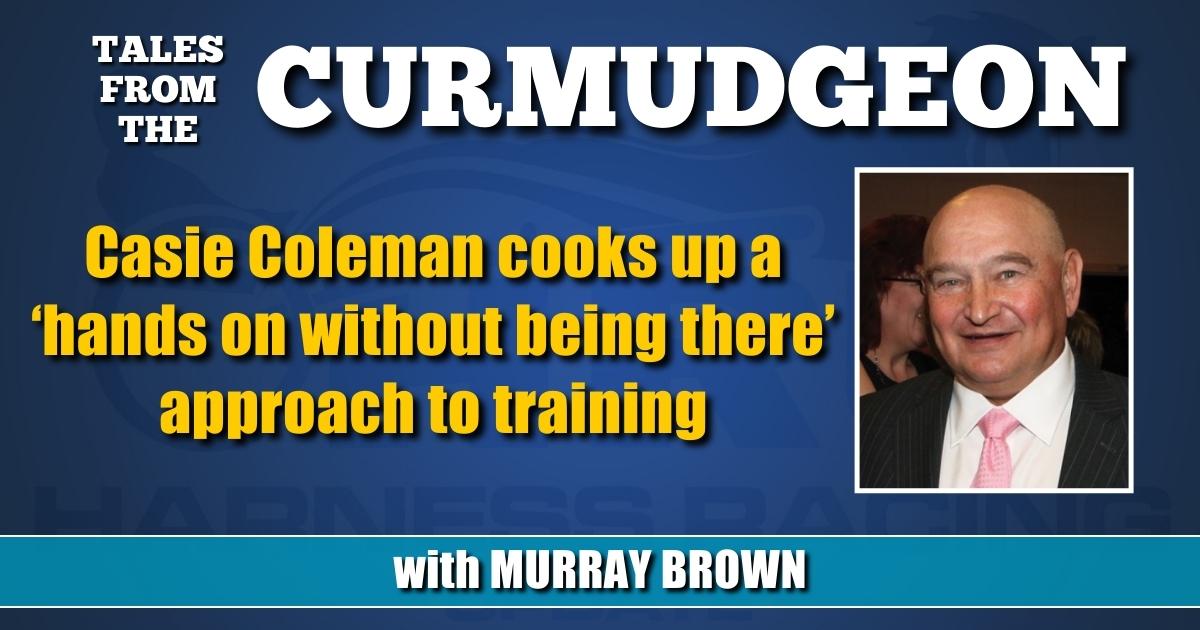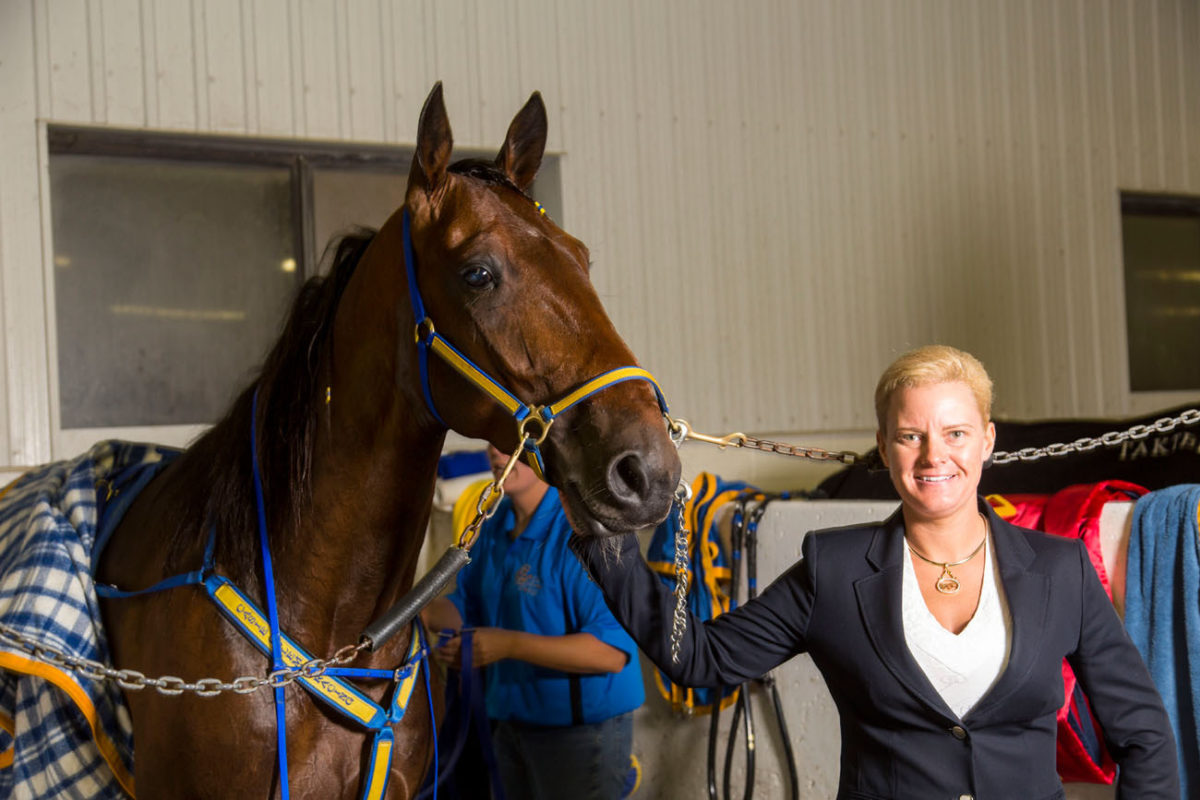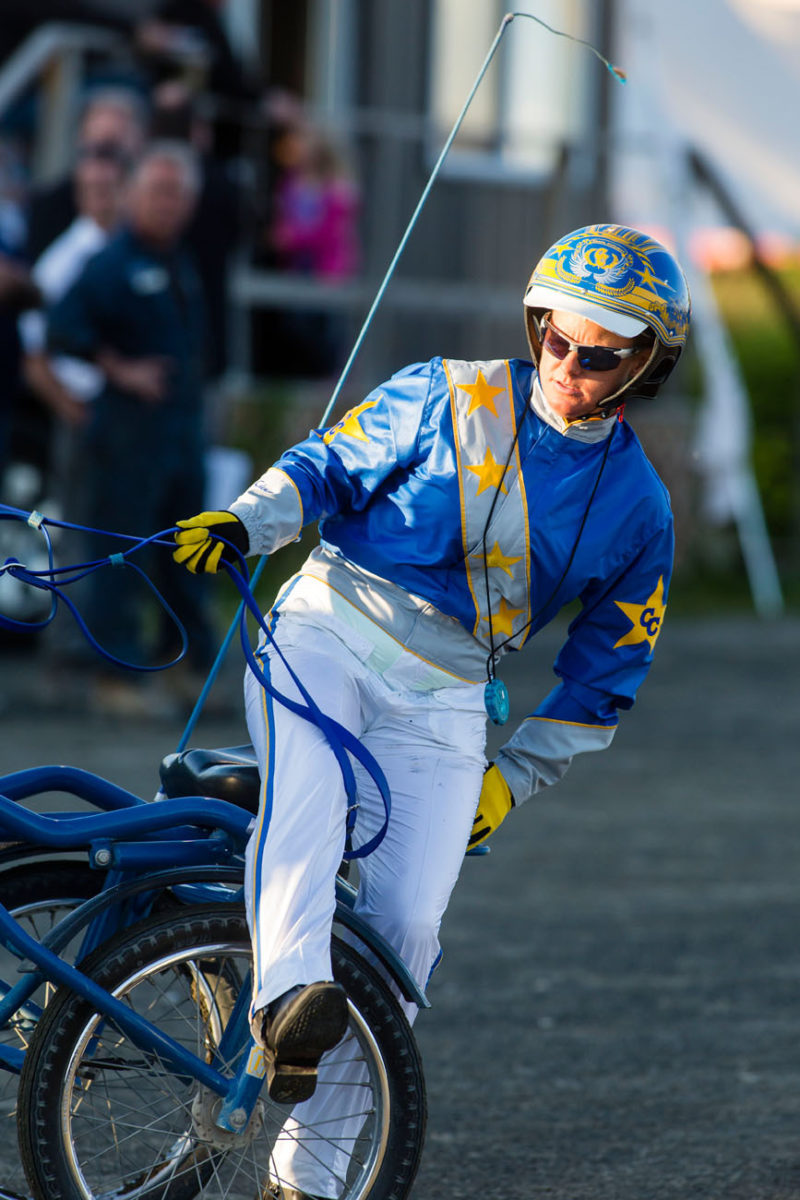

Casie Coleman cooks up a ‘hands on without being there’ approach to training
by Murray Brown
If her parents had made the decision, Casie Coleman might today be Chef Casie, with a whole bunch of Cordon Bleu awards instead of having a whole bunch of O’Brien Awards on her mantelpiece.
She was offered a scholarship at a prestigious cooking school in her native British Columbia. At the last moment she decided that was not where her heart was. She wanted to be a driver of harness horses. Yes, a driver. She thought of training horses as being somewhat boring, whereas driving was where the action was. When asked about her ability as a driver, Coleman’s response was: “I think I was pretty good. Maybe a little over aggressive at times, but I think I could make horses go.”
Sometime after a near death experience in a fire, the result of which necessitated 22 per cent of her body to require skin grafts, she made the decision to move east which was where the action was. She got some drives, but not many. She needed the means to survive. At that point, she decided to become a trainer. It couldn’t be too hard. She had been around horses all of her life. She determined that going the claiming route might be the road at which to begin.
Today you are best known as a developer of young horses, yet for quite some time you had a stable composed of claimers and overnight horses with nary a stakes horse in sight.
“I suppose that you could say that I hit the ground running. At the risk of sounding cocky, I found it rather easy to improve upon horses who were in claiming races. It was quite the norm for me to look at a horse and see that it may have been under nourished, poorly shod or deficient in other areas where good horsemanship, nutrition, hard work and good common sense might turn it around quickly. That’s what happened with me. I was doing well, extremely well. Before too long I had a stable of 100 head spread out at WEG, The Meadowlands and Yonkers.
“As is often the case in this business, when you are doing well people are going to say that you are cheating. They said I was using contraband which was giving me an unfair edge over the opposition. Before too long, the folks at WEG began to believe the rumors. At first, they put me in 24-hour detention. Then they upped it to 48 hours. My horses were stabled near Mohawk and they had several in detention at Woodbine where I wasn’t. It became an incredible burden. My racehorses were in effect taken away from me. The horses and my schedules were totally disrupted. I had to rely on thoroughbred horseman to feed and look after them. Added to this was the vicious gossip going on accusing me of God knows what.
“All this despite the fact that with a stable of 100 head my record was close to spotless. Claiming races were a strong part of the racing schedule, their numbers had been decreased to the point where it became somewhat difficult to get my horses raced. I decided that a change was in order. I was going to start developing young stakes horses. How could that be more difficult than racing in overnights? After all they all were racehorses doing the same thing; hopefully winning races.”
At what point did you think that the transition to stakes horses was going to work?
“I was at the Harrisburg sale in 2008. As I normally do, I had looked at a whole bunch of yearlings. I don’t know this as a fact, but I would guess that I look at more, or at least as many pacing yearlings as anybody in the business. I not only look at them initially, but for the ones that appeal to me, I keep going back, and going back and going back again. I don’t know how I missed one that I should have looked at, but I did.
“I was walking by the Hunterton Farms consignment and Jim Avritt asked me if I had looked at his Artsplace colt. For some unknown reason I had not. ‘Let’s look at him,’ I said. Wow! I was immediately enthralled. In my mind, I was sure that this was a six-figure colt. There was no way I could afford to buy him. I supposed that I could have rounded up a few owners to come up with the money to buy him if he didn’t bring too much. As luck would have it, I was speaking with Steve Calhoun, one of my biggest owners, that evening.
“At the time, Steve felt that buying yearlings was a fool’s game. Why buy a yearling when you had to wait so long and invest more money when you could buy a claimer, watch him the next week and get an immediate return on your investment? I happened to mention to Steve that I had looked at this colt with which I fell in love. I told him that he would probably bring between $150,000 and $200,000. I couldn’t afford him at near those numbers.
“As luck would have it, I ended up buying him at $50,000. Even at that price I couldn’t afford it, but I somehow would make it work. I, together with my long-time partner Ross Warriner, would buy a chunk of him. I’d somehow figure out how to pay for the rest. Steve called me that evening and said ‘I see that you bought that colt for less than half than you thought he would bring. Can I get in for part of him?’ What? This guy who said that the yearling game was for fools was now wanting to buy into a yearling? I asked him how much he wanted. He said he would take half. I then asked him about yearling buying being a fool’s game? ‘I’m a person who is always looking for value’ he said. ‘I thought that buying a yearling for half of what you thought it was worth represented great value.’ Of course, that colt was Sportswriter. He earned $1,566,460 racing and then millions in the breeding shed.”
You are now in the yearling game. What came next?
“A huge change in lifestyle for me; all for the better. I gradually worked my way out of the overnight business. I started selling horses and reducing the size of my stable. Doing that made my life less stressful. I thought about going to Florida with my stable and then I just did it. I had just about had enough of the cold Canadian winters. It was especially hard on me because of the residual effects of the skin grafting. I had downsized successfully. The stable was doing well and so was I.”
Let’s talk about some of your better horses.
American ideal: “This horse had unbelievable speed. Mac Nichol bought him as a yearling for $72,000. He sent him to Western Canada to race at 2. He was just too good for the horses out there. I got him towards the end of his 2-year-old season. At 3, he drew the 10-hole in the North America Cup, Meadowlands Pace, Breeders Crown yet still earned $747,570. He would have won more if he had been eligible to more stakes, but there were only a few where we could put him in. He was the only one of my good stud horses where I didn’t own a piece. Mac Nichol was kind enough to give me two free lifetime bookings to him. Of course, I got McWicked well into his racing career. His owner Ed James also gave me two lifetime breedings.”
Sportswriter: “Probably the one horse to which I owe much of my success. He got me on my way. I learned a very valuable lesson from him. That is, if I were buying yearlings to make sure that I owned a piece of the ones I buy. He is the horse that keeps on giving, both on the racetrack, earning $1,566,460 and in the stud barn where he has brought in millions. Even at the advanced age of 16, he is still contributing.”
Betterthancheddar: “I bought him for only $30,000 as a yearling. I probably wouldn’t have gone much higher. I generally am attracted to horses with good manners. BTC was anything but that as a yearling. He was a bit of a renegade, even at the sale. He could even sometimes be mean. But he was all manners on the racetrack. If you reprimanded him for his bad behavior he would sulk just like a spoiled child. He ended up earning $1,634,314 and is now one of the best pacing sires in Ontario.”
Vegas Vacation: “He was a bit of a head case and wasn’t an easy horse to manage. He was also quite a bargain. We gave $32,000 for him. He went on to earn $1,162,272 and gave me my first Little Brown Jug win.”
Michaels Power: “He was a homebred. Jeff Snyder gave him to me to train. He was probably the gamest horse that I’ve ever had in the stable. He was always a little sore, never really lame, but never completely sound either. He earned $1,908,226 and gave me my second Little Brown Jug.”
Betting Line: “Almost certainly the very best horse I’ve had in my stable. We bought him for what I thought was a bargain at $60,000. He never trained bad. He never raced poorly. If he had a fault, I have no idea what it might be. He won $1,908,226, took on all comers and beat them, sometimes seemingly with ease and gave me my third Jug winner.”
McWicked: “A truly great warhorse. I had no part in buying or making him. I was privileged to be able to race him as a made horse. He was retired after earning $4,903,967.”
It has been a great ride for you coming from a track in British Columbia to the big stage at WEG, en route to capturing five O’Brien Awards and winning classic races throughout North America. Are there any people who you feel helped you on your way?
“There have been lots of them. I’ll just mention five that come immediately to mind. There are others as well.
1. “Bill Davis: He was the first great horseman that I was around. I learned so much from him; most importantly how to take care of a horse.
2. “David Miller: One of the greatest drivers and finest people in our sport›s history. Because he can be so quiet, he is sometimes overlooked in discussing greatness. You can trust me on this, he is one of the great ones.
3. “Linda Toscano: A wonderful person and a great horsewoman. She does things the right way. Her results prove that.
4. “Jimmy Takter: He›s insanely good. Looking at him, I sometimes think that he has to be part horse. I think that may be part of the reason for his overwhelming success. I believe that he has taught himself to think like a horse. He does it all and he does it all well.
5. “Phil Coleman: My dad. He has always been there when I›ve needed him.”
This year begins a new chapter in your career. You trained your horses at Sunshine Meadows in Florida this past winter. Now you’ve shipped them to Anthony Beaton in Ontario to race. You aren’t giving up training, are you?
“No way. Not by a longshot. I call what we are doing ‘Hands on without being there.’ I’ve shipped 14 head to Anthony Beaton, 10 2-year-olds, three 3-year-olds and Linedrive Hanover. I also own a piece of a Betterthancheddar colt that Tony bought in Kentucky. He was kind enough to let me get in as a part owner.
“I’m now in Florida, but plan on going back and forth once they begin racing regularly. Tony worked for me for 11 years. He knows how I like things done and he does them the same way for himself. I expect things to work out well. Its springtime; a time for optimism. I expect things to work out well. If they need some revision, we will do that as well.”

















